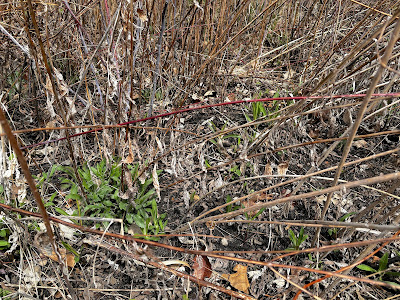 |
| tallgrass prairie in April |
Tallgrass prairie once stretched across a dozen states in the center of North America. Minnesota was at the northern edge, where grassland met forest. Some places in the world the transition from forest to grassland is gentle, with trees becoming ever more scattered, until it is grassland. On the east edge of the tallgrass prairie, the transition was abrupt; in one spot there was forest, a few steps westward it was grass as far as the eye could see, treeless. Fire maintained the tallgrass prairie; for hundreds of miles into the prairie there was enough rainfall for trees, but recurrent wildfires killed them, leaving only grasses. Minnesota's forests ended where streams or hills no longer blocked the fires.
 |
| Closer up, the prairie was still very brown |
 |
| Here and there, green leaves were visible |
The prairie at the Minnesota Landscape Arboretum, close to Minneapolis-St. Paul, was planted 60 years, ago combining sod from local prairies with native seed. It is maintained by periodic burning. Most tallgrass prairies are easily invaded by shrubs and trees, shading the grasses until they die. Tallgrass prairie has been reduced to about 1% of its original extent, and nowhere does it have the native mammals (bears, elk, bison). Much of the destruction was plowing for farming, but shrub invasion continually threatens prairie remnants.
 |
| History of this prairie |
I walked the trails in the Arb's tallgrass prairie in late April. It seemed a pile of dead grass. And yet, like other temperate ecosystems, it has early spring wildflowers to surprise the hiker.
Where the grass is dense, wildflowers are slow to appear. In burned or bare spots, they are much earlier.
Fire was an important element in tallgrass prairie. Probably every part of it burned every three to five years; the dead grass carried a fire easily, the ecosystem is windy, and historically there were few barriers in the gently rolling countryside to stop a fire once it got started. Lightning or people started the fires, then they burned for many miles. But a grass fire passes quickly over the ground; behind the fire the surface is cleared and sunlight and rain both reach the plants in the ground more easily than through last year's dead grass. The aftermath of a fire really enhances the flowering of the scattered spring wildflowers. Fire adds one to two weeks to the growing season and the spring wildflowers take advantage of it.
At the Arboretum, this could be seen by comparing the brown and apparently lifeless prairie, and the adjacent flower beds of prairie wildflowers which had been cleared of last year's dead stems. In the flower beds, the wildflowers were up and flowering.
 |
| prairie wildflower bed; there are some buds and flowers |
My favorite spring prairie wildflower is pasque flower also called prairie crocus (Anemone patens or Pulsatilla patens in the buttercup family, Ranunculaceae). (There's a bud center front in the photo above, but it is hard to see). Pasque means Easter in French, and was the name the trappers gave it, Easter flower. It an anemone, but has long been separated into a distinctive group of its own. At present experts do not agree, some calling it Anemone patens emphasizing similarities and others Pulsatilla patens, emphasizing differences. The most rigorous application of naming rules calls it Anemone, but the traditionalists are holding out strongly for Pulsatilla. Use whichever name you like. The pasque flowers near my home on the Colorado Front Range are pale purple, nearly white. These at the Minnesota Arb were a gorgeous purple. The Minnesota Wildflowers website shows pale ones, so walking Minnesota prairies in the spring, you might pale to dark pasque flowers.
 |
| American pasque flower, Anemone patens |
This is prairie smoke, Geum triflorum (rose family, Rosaceae). It has pretty reddish flowers, but is named for the feathery seed pods (see photos: Wisconsin Extension website), a lovely plant throughout the year.
 |
| prairie smoke, Geum triflorum |
Leaning out into the flowerbed, I saw a yellow flower, the early buttercup, Ranunculus facicularis (buttercup family, Ranunculaceae). This buttercup has the spreading divided leaves you see, but there is also a prairie buttercup, Ranunculus rhomboideus, with oval leaves, that can be found in Minnesota's prairies as well.
 |
| early buttercup, Ranunculus facicularis |
Prairies have other early spring flowers, violets, for example.
Most spring prairie wildflowers probably live long enough to wait four or five years for a fire to clear off the grass, letting in sunlight and making it easy for pollinators to find them. That year they set lots of seeds, then wait patiently for the next opportunity to flower abundantly. In a garden situation, they grow big and flower regularly.
Early spring wildflowers are such a joy to encounter!
Comments and corrections welcome.
References
Minnesota Wildflowers. no date given. Anemone patens (American pasqueflower). Minnesota Wildflowers website link Accessed 5/13/25
Minnesota Wildflowers. no date given. Geum triflorum (prairie smoke). Minnesota Wildflowers website. link Accessed 5/13/25
Minnesota Wildflowers. no date given. Ranunculus fascicularis (Early buttercup). Minnesota Wildflowers website. link Accessed 5/13/25
Minnesota Wildflowers. no date given. Ranunculus rhomboideus (Prairie buttercup) Minnesota wildflowers website link Accessed 5/13/25
(personal research in and on tallgrass prairies, 1975-2006).
Kathy Keeler
A Wandering Botanist
More at awanderingbotanist.com
Join me on Facebook: https://www.facebook.com/AWanderingBotanist
"Early spring wildflowers are such a joy to encounter!" ... I sooooo agree!
ReplyDeleteSo lovely.
ReplyDelete